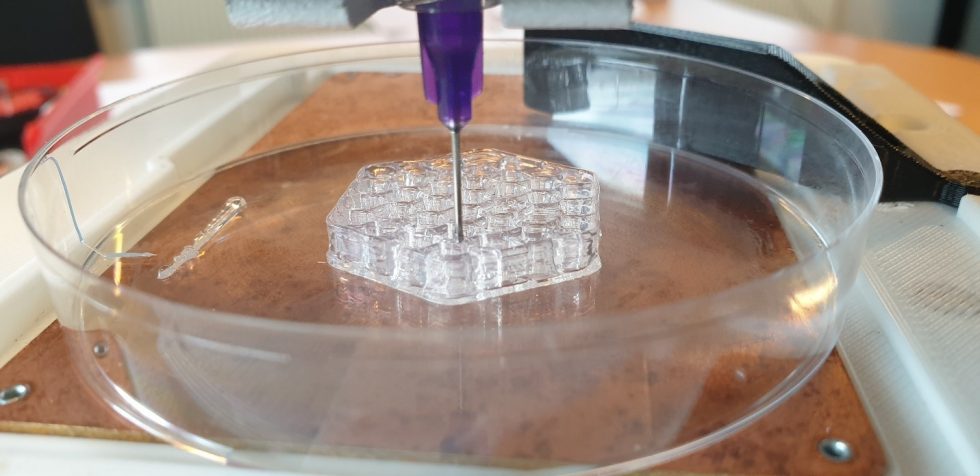Biomaterial solutions provider Xpect-INX announced a collaboration with FELIXprinters, a Dutch manufacturer of innovative industrial 3D printers, to further expand the commercialization of its bioinks and consolidate research in the healthcare field. The distribution agreement will help build a strong foundation that will contribute to the growing demand for bioprinters.
Since the first blood vessels were bioprinted using living cells in 2009, research applications and breakthroughs in bioprinting technology have disrupted the industry. The “Bioprinting Markets: Materials, Equipment And Applications – 2017 To 2027” report from SmarTech Analysis suggests that, by 2027, bioprinting applications will generate over $1 billion in revenue. This is accompanied by a healthy market in specialist bioprinting hardware and materials. As studies continue developing live materials, such as skin, cartilage, liver, and other organs, researchers expect to access low-cost, high-performance 3D bioprinters that will fit their budgets. This is true particularly in European Union (EU) countries that have witnessed severe budget cuts in 2020.
FELIX’s first hybrid bioprinter has been very competitively priced and is accessible across many research laboratories throughout Europe. Launched commercially in the fall of 2020, the BIOprinter is a versatile, entry-level device, selling for €9,650, below the €10,000 cash amount usually awarded as research grants for academia and institutes in Europe to purchase machines. BIOprinter designer Hakan Gürbüz, a Marie Curie Early Stage Researcher and engineer representing FELIXprinters, said to 3DPrint.com in May 2020 that “the expensive bioprinters in research labs are usually for the exclusive use of a few professors.” Instead, the BIOprinter is meant to be a great addition for anyone with a desire to create skin models, print oral drugs, tissue, and even food.
Now, FELIX will incorporate high-quality Xpect-INX bioinks especially tailored for its BIOprinter to create workable substitutes for human tissues. As a spin-off company from the Polymer Chemistry and Biomaterials research group at Ghent University (UGent) in Belgium, Xpect-INX focuses on developing innovative new bioprinting materials. Its range of in-house, polymer-based materials for biomedical and industrial applications includes water-soluble resins, biodegradable resins, and biocompatible resins for digital light processing (DLP), stereolithography (SLA), and multi-photon lithography applications.
Xpect-INX will not only tailor its high-quality bioinks for the FELIX BIOprinter but will also engage in constant mutual developments as part of the collaboration. Moreover, the company considers that this agreement can help consolidate the first steps towards “the future of healthcare.” By launching Xpect-INX, co-founder Jasper Van Hoorick said that the objective was to meet the demand for more and better materials suitable for 3D printing, which he considers to lag behind the more advanced technological hardware developments.

Jasper Van Hoorick with Ghent University’s Polymer Chemistry & Biomaterials research group. Image courtesy of Xpect-INX.
In searching for developing more reliable, innovative bioinks, Xpect-INX aims to capitalize on years of academic research to take high-quality products to market. In addition to the range of bioinks and polymers recently launched, the company wants to continue developing customized material formulations and 3D bioinks for its customers’ specific applications. In this way, the spin-off can meet companies’ demands that focus on an end application that requires particular material properties. For example, in December 2020, Xpect-INX established collaborative efforts with Spanish printer manufacturer Regemat 3D to develop the first series of materials for biomedical applications to create workable tissues like corneas, breast reconstructions after mastectomy, or replacement constructs for damaged hearts. Furthermore, the company also serves the high-resolution lithography market through a cooperation agreement with UpNano, an Austrian multiphoton lithography manufacturer.
According to Xpect-INX, the biofabrication field has the potential to revolutionize modern healthcare. However, to reach life-saving breakthroughs, researchers, clinicians, and the industry must access the right tools. UGent has obtained several unique patents in the last years that give researchers a competitive advantage, so the switch to a spin-off was the logical evolution. Xpect-INX bioinks are based on two core patented technologies, Curasol and Curaduo, and offer efficient solid-state curing of polymers and faster cross-linking of gelatin-based inks, respectively. The company also develops hydrogels with shear-thinning behavior that are very beneficial for deposition-based 3D printing with high-shaped fidelity.
As bioprinting hardware technology continues to advance, there is a growing demand for printable and biocompatible materials that can significantly impact clinical fields of research. Even though much academic research never gets to bridge the gap between academia and the real world, some projects came full circle to the point of commercializing their product, like Xpect-INX. A big part of their success relies upon effective collaborations that lead to greater innovation and enhanced products.
Subscribe to Our Email Newsletter
Stay up-to-date on all the latest news from the 3D printing industry and receive information and offers from third party vendors.
Print Services
Upload your 3D Models and get them printed quickly and efficiently.
You May Also Like
Reinventing Reindustrialization: Why NAVWAR Project Manager Spencer Koroly Invented a Made-in-America 3D Printer
It has become virtually impossible to regularly follow additive manufacturing (AM) industry news and not stumble across the term “defense industrial base” (DIB), a concept encompassing all the many diverse...
Inside The Barnes Global Advisors’ Vision for a Stronger AM Ecosystem
As additive manufacturing (AM) continues to revolutionize the industrial landscape, Pittsburgh-based consultancy The Barnes Global Advisors (TBGA) is helping shape what that future looks like. As the largest independent AM...
Ruggedized: How USMC Innovation Officer Matt Pine Navigates 3D Printing in the Military
Disclaimer: Matt Pine’s views are not the views of the Department of Defense nor the U.S. Marine Corps Throughout this decade thus far, the military’s adoption of additive manufacturing (AM)...
U.S. Congress Calls Out 3D Printing in Proposal for Commercial Reserve Manufacturing Network
Last week, the U.S. House of Representatives’ Appropriations Committee moved the FY 2026 defense bill forward to the House floor. Included in the legislation is a $131 million proposal for...


































